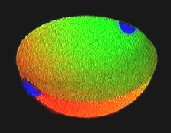The MÖBIUS BAND and
The Projective Plane
(Page 1 of 2)
Introduction
The idea of the projective plane arose from the study of perspective
by mathematicians and painters in the Renaissance. It was one
of the reasons why Leonardo wrote in his notebooks:
`Let no one who has not studied mathematics read these books.'
In trying to represent parallel lines in space on the two dimensional
surface of a painting, it was found useful to introduce the notion
of a `line at infinity' on which parallel lines met. The study
of the geometry which adds to the ordinary plane we know this
extra line of `ideal' points came to be known as projective geometry,
because of its utility for studying projections of figures onto
different lines. This idea was even more important in three dimensions,
since projections are used for representing three dimensional
figures on planes, that is for making realistic drawings.
The plane with this line at infinity is the The Projective Plane. There are various ways of representing it. One such way uses
the Möbius Band, and our explanation gives a link with motion in space.
Rotations and the Projective Plane
Mathematics is often required to represent data, and to show how
this data changes. For this, mathematicians have found many notions
of `space', to act as storage for the data of motion. A particular
space allows for a record of how bodies move, of how situations
change. In science the term phase space is used to describe the space of all possibilities in a given
situation. A motion is then described by what we call a path in
this space, not your usual path laid out on the ground for you
to follow, but a series of positions in space, describing motion
or change over a period of time.
Our pictures illustrate the space of positions of a pivoted rod,
giving different presentations, different pictures, of this space.
Each such picture may be useful in its own way.
We begin our illustration with a moving pivoted rod in our 3-dimensional
space, moving either randomly or in a regular fashion. It is important
for our purposes that this rod has no direction, so that rotation
through 180 degrees brings it back to itself.
|
|
 |
 |
|
We start to simplify our picture. We introduce a sphere, centred
on our pivot. We need only part of the rod to specify all of it
so we omit the part of the rod outside the sphere. The rod meets
the sphere in two points, which we show as discs.
|
These two moving discs contain all the information about the position
of the rod , and so we can omit the rod, leaving the two discs.
These two moving discs still record more information than is necessary.
We can recover the rod from the information contained in half
the sphere (since we know the centre of the sphere). So we gradually
make the top half of the sphere, with its moving discs, invisible,
leaving a hemisphere and, apparently, only one moving disc.
|
|
 |
 |
|
As this disc moves across the equator, it seems to appear on the
opposite side of the hemisphere, but really it was the other moving
disc which has now become visible.
|
So we represent the moving pivoted rod in our usual space by the
picture of a point or disc moving on a hemisphere, with the rule
that opposite points of the equatorial circle of the hemisphere
are to be thought of as glued or sewn together, since the disc
(apparently) jumps from one point of the equator to the opposite
point. This gluing cannot be done in three dimensions, so instead
what we do is just record the information that this gluing is
to be done, as shown by the motion of the disc.This hemisphere
with parts glued together is a complicated space.
There is another useful picture of it, which brings in the Möbius
Band. Take small semicircular pieces, including parts of the equator,
out of opposite sides of the hemisphere. We glue these pieces
together, with a twist, and they form a disc.
|
|
 |
Projective Plane 2

© Mathematics and Knots/Edition Limitee 1996 - 2002
This material may be used freely for educational, artistic and
scientific purposes, with acknowledgement, but may not be used
for commercial purposes, for profit or in texts without the permission
of the publishers.




